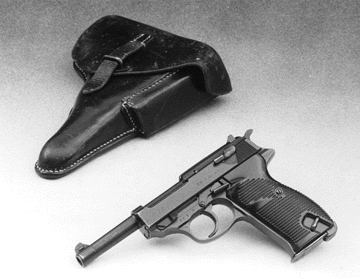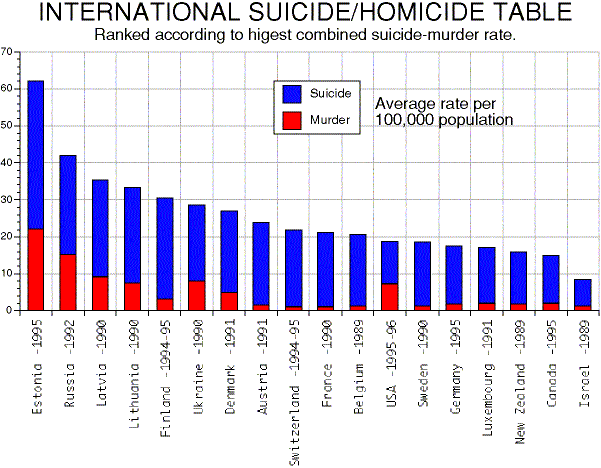
Peaceful societies do not need general gun bans,
and violent societies do not benefit from them.
Take a look at the facts the gun-grabbers
don`t want you to know.
By Don B. Kates
Americans have been gravely misled about foreign gun ownership and the severity and effectiveness of foreign gun bans. It simply is not true to state that "the U.S. has more gun availability and far less restriction than any other modern industrial nation."
That honor goes to Israel where, nevertheless, murder "rates are much lower than in the United States despite ... [Israel`s] greater availability of guns to law-abiding civilians," writes Israeli judge Abraham Tennenbaum (formerly an official with the Israeli National Police and then a professor of criminology).
Europe
Equally erroneous is the impression that Europe is uniformly anti-gun. Laws vary. Luxembourg totally bans all guns from civilian ownership. France, Belgium and Germany allow citizens to own handguns but these countries are more restrictive than most U.S. states. In Austria, every law-abiding citizen has a legal right to buy handguns, and roughly ten per cent of Austrians have done so (compared to 16 per cent of U.S. citizens).

A shooting festival in Switzerland, with the young folks carrying their STGW 90 5.6mm assault rifles.
Switzerland
And then there is Switzerland, where the laws are similar to those in Israel and gun availability is comparable to that in the U.S. In Switzerland, handgun licenses are available to any law-abiding applicant. In half the Swiss cantons (similar to U.S. states), licensees are free to carry their personal handguns concealed. Beyond this freedom of ownership, every law-abiding military-age Swiss male is issued a firearm and he must keep it at home to perform his mandatory militia obligation.

Switzerland`s enlisted men are required to keep at home the STGW 90 assault rifle ("Sturmgewehr") (above), which fires both full- or semi-auto. Retired militiamen may buy their issued firearms. Below: The Walther P-38, one of several pistols that the Israeli government furnishes to its citizens, including teenagers.

For the 263,000 officers and non-commissioned officers, the issued firearm is a 9 mm Parabellum semi-automatic pistol, either the SIG-Sauer P210 or its successor, the SIG-Sauer P220. For the millions of enlisted men, the issued firearm is an assault rifle: the STGW 90. The STGW 90 is a version of the SIG-Sauer 550 semi-automatic rifle that is select-fire, meaning it may be fired in either full- or semi-auto mode. When he retires, any Swiss militiaman who wishes to buy his issued firearm may do so.
Homicides in Europe
Homicide rates are quite low in all the nations mentioned above. However, the homicide rate in handgun-banning Luxembourg is much higher than in the others: 2.1 per 100,000 population, versus 1.2 and 1.1 per 100,000 for "handgun-ridden" Israel and Switzerland--which have the lowest homicide rates of all. (The accompanying table provides the references for homicide and suicide rate comparisons discussed in this article.)
Western Europe, in fact, has always had very low homicide rates as compared to the U.S. This is not something caused by strict anti-gun laws, because this low homicide rate existed before such laws were adopted, and the low rate occurs also in Switzerland and Austria which have no such strict anti-gun laws.
European anti-gun laws only arrived after World War I, and they were not passed in order to curb crime. They were passed in response to the political violence of that tumultuous era (1918-1939) between the two World Wars.
Whatever their purpose, European anti-gun laws have miserably failed. They have not prevented assassination, terrorism, and other political violence--problems occurring throughout Europe on a fairly regular basis, but not so in the U.S. Neither have these anti-gun laws stopped non-political crime, which has steadily increased throughout Europe since World War II.
To this issue, the further question has been asked, "Why has Europe had so much less non-political violent crime than the U.S.?" Yale University`s preeminent historian, Dr. C. Vann Woodward, suggests an answer. He writes, "The impact upon Europe of the emigration [to the U.S.] of 35,000,000 Europeans in the Century between the Napoleonic Wars and World War I remains to be acknowledged. The importance of the West as a safety valve for American society has undoubtedly been exaggerated. But the significance of America as a safety valve for Europe and the effect of the closing of that safety valve after World War I remain to be fully assessed." 1
Suicides in Europe
Nor, finally, have these anti-gun laws stopped suicide, something which has always been a much greater problem in Europe than in the U.S. In this respect, one can note a curious (but invariable) omission when anti-gun articles compare the U.S. to Europe.2
Anti-gun propaganda emphasizes suicide as well as homicide. U.S. suicide rates have risen over the past quarter century (while U.S. homicide rates have declined). However, anti-gun advocates recently have taken to combining suicide and homicide figures in the U.S. This allows them to conceal the decline in U.S. homicide rates (and to exaggerate the so-called "societal costs" of gun ownership). They have done this more particularly in the last few years while the U.S. homicide rate has been declining (despite a 100 per cent increase in handgun ownership since the 1970s).
But then, inconsistently, when comparing the U.S. to Europe, they only compare the homicide rates. They never use the combined homicide-suicide figure--because it would refute their entire argument; it shows that Europe`s homicide-suicide combined rates are higher than that of the U.S.
INTERNATIONAL SUICIDE/HOMICIDE TABLE*
(*Ranked according to highest combined suicide-murder rate; nations ranked higher than the U.S. in either suicide or murder rates are in bold face)
|
Country |
Year |
Suicide |
Murder |
Combined |
|
ESTONIA |
1995 |
39.99 |
22.11 |
62.1 |
|
RUSSIA |
1992 |
26.6 |
15.3 |
41.9 |
|
LATVIA |
1990 |
26. |
9.2 |
35.2 |
|
LITHUANIA |
1990 |
26. |
7.5 |
33.5 |
|
FINLAND |
1994-95 |
27.3 |
3.3 |
30.6 |
|
UKRAINE |
1990 |
20.6 |
8.0 |
28.6 |
|
DENMARK |
1991 |
22. |
5.0 |
27.0 |
|
AUSTRIA |
1991 |
22.3 |
1.5 |
23.8 |
|
SWITZERLAND* |
1994-95 |
20.8 |
1.1 |
21.9 |
|
FRANCE |
1990 |
20.2 |
1.1 |
21.3 |
|
BELGIUM |
1987 |
19.3 |
1.4 |
20.7 |
|
UNITED STATES* |
1995-96 |
11.5 |
7.3 |
18.8 |
|
SWEDEN |
1990 |
17.2 |
1.3 |
18.5 |
|
GERMANY |
1995 |
15.8 |
1.8 |
17.6 |
|
LUXEMBOURG |
1991 |
15.1 |
2.1 |
17.2 |
|
NEW ZEALAND |
1989 |
13.9 |
1.9 |
15.8 |
|
CANADA |
1995 |
12.9 |
2.0 |
14.9 |
|
ISRAEL |
1989 |
7.3 |
1.2 |
8.5 |
*All information in this table dated before 1993 comes from the U.N. Demographic Yearbooks for 1993 and 1992. All information dated 1993 and thereafter comes from a draft study prepared for the U.N. Commission on Crime Prevention and Criminal Justice`s Vienna Session 28 April-9 May, 1997, except: a) the U.S. homicide figure comes from FBI preliminary data for 1996, and b) the Swiss homicide and suicide rates come from the Swiss national police.
Combined Homicide-Suicide
Look to the accompanying table for the result obtained when the anti-gun forces` combined homicide-suicide approach is applied to the international figures: The U.S. combined homicide-suicide rate falls in the middle of the nations, and is lower than eight European nations. Even compared to the nations with lower combined rates, the U.S. rate is only slightly higher.
Of the 18 nations shown in the table, the U.S. ranks in the middle as to murder and suicide combined. The lowest rate of all is for Israel, the nation where guns are the most available and supplied to citizens, including teenagers.
My point is not that gun availability reduces suicide, or even murder. Statistics show that the relatively crime-free nations don`t appear to need or benefit from severe anti-gun laws.
Western Europe
The table clearly shows that, regardless of their gun laws, Western European nations have roughly comparable rates of both murder and suicide. This cannot plausibly be attributed to severe handgun restrictions because the highest murder rates among these nations are in the nations with the most restrictive gun laws (Luxembourg, Denmark, Germany). In those restrictive nations, the average murder rate of 2.73 per 100,000 population is over twice as high as the 1.26 average rate of Switzerland, Israel and Austria, where gun laws are least restrictive).
Russia and the Baltic Countries
Even less do gun control laws benefit high crime nations like Russia and its former possessions, the countries of Estonia, Latvia, Lithuania and the Ukraine. When these and other countries were under the control of the former Union of Soviet Socialist Republics, the central Soviet government totally banned civilian handgun ownership.
The Soviet government uniquely implemented the ban by creating after World War II a unique caliber cartridge for Soviet handguns (9 x 18 mm). This cartridge is too short to interchange with handguns using the familiar European standard 9 x 19 cartridge (9 mm Parabellum, or 9 mm Luger, as Americans commonly call it); it`s too long to interchange with handguns shooting the .380 cartridge. This meant that anyone smuggling foreign handguns into the USSR (for example, soldiers returning from foreign wars) would find ammunition unavailable.3 Nevertheless, though exact statistics were never released, analysis clearly indicates that Soviet homicide rates far exceeded those in the U.S. 4
With the USSR no longer in existence, the homicide rates in the former Soviet republics and Russia continue to exceed those in the U.S., as shown in the accompanying table. Under the Soviet regime, with strict gun control, the weapons used for homicides were largely knives, clubs, and other non firearms. Today, though handguns remain virtually unavailable to ordinary Russian citizens, homicide rates remain high, being committed by those criminals in Russia, Latvia, Lithuania, etc., who seem to have no difficulty acquiring both Russian and foreign-made handguns and suitable ammunition.
Violence in Any Society
Such international statistics show the pointlessness of gun bans. In any society, truly violent people are only a small minority. We know that law abiding citizens do not commit violent crimes. We also know that criminals will neither obey gun bans nor refrain from turning other deadly instruments to their nefarious purposes.
It is obvious and well-proven that the amount of violence in any particular society is determined not by the mere availability of any particular form of weapon, but by cultural, socio-economic and institutional factors that produce people willing to engage in extreme violence.5
How much violence occurs in any given society will depend on the proportionate size of truly violent people.
In sum, peaceful societies do not need general gun bans and violent societies do not benefit from them.
Don B. Kates is a San Francisco-based criminologist, professor, and constitutional lawyer. Among his many published works is, The Great American Gun Debate: Essays in Firearms and Violence (Pacific Research Institute, 1997), by Don B. Kates and Professor Gary Kleck of the Florida State School of Criminology (available for $17 plus $3 for postage and handling, and 8.5% tax for California residents, from the Pacific Research Institute, 755 Sansome St., San Francisco, CA 94111; telephone (415) 989-0833).
This article first appeared in The American Guardian, October, 1997.














 More Like This From Around The NRA
More Like This From Around The NRA








